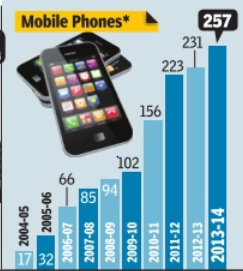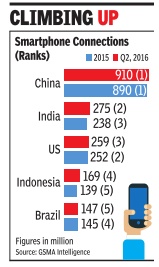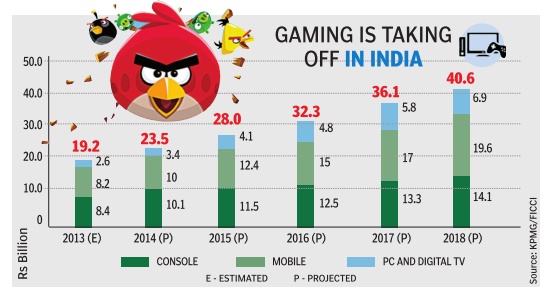Cell/ Mobile phones: India
This is a collection of articles archived for the excellence of their content. Readers will be able to edit existing articles and post new articles directly |
Cell phones: India
Contents |
Smart-/ cell- phones made in India
Ringing Bells
The Times of India, Feb 19 2016
Pankul Sharma
Until Ringing Bells, Goel had small grocery shop
The whole country is today talking about Ringing Bells, Mohit Goel's Rs 251 smart phone His father Rajesh Goel, though, sitting in his smalgrocery shop that proclaims its name to be `Ram ji' on a grey board doesn't know what the fuss is all about. He says he always knew his son would do some thing big. Even in Garhipukhta asmall town in Shamli district o Uttar Pradesh, not many knew about the Goels or their shop. It's a different story today. They are suddenly all that everyone here is discussing. Goel Sr, who is now also one o the directors of the company the directors of the company said, “ After completing his schooling, Mohit went to Noida and competed his graduation from Amity University . The last time that he was home to meet us he had expressed his desire to open a company and I loaned him some money to start what he wanted to. Then he started a mo bile phone company and told us about his venture. Little did we know what it meant then. It's re ally big, is it? We also attended the event where Freedom 251mo bile was launched in New Delhi.“
Mohit, who is the managing director of Ringing Bells, has lived with his father at Garhipuk hta most of his life, often helping around in the grocery shop. On Thursday , Ringing Bells launched Freedom 251, the mobile phone, in a glitzy event in New Delhi that was attended by several dignitaries, including senior BJP's Murli Manohar Joshi.A few residents from Shamli were also invited to the launch.
After completing his schooling from Saint RC Convent School, Mohit earned his engineering degree from Amity University. He recently married Dhaarna, a Noida resident, who is now CEO of Ringing Bells.
6 lakh hits per second lead to co's website crash
This surely is a dampener after the excitement created around the Rs 251smartphone, unveiled by a Noida-based company -Ringing Bells. The company's website only way to book the phone could not f take orders on Thursday. According to those who logged on to the , website, bookings could not be made, even though some had logged in very early in the day. Earlier, Ringing Bells had said that people can make a booking for the phone from its website from 6 am onwards. However, the company in a written message on the website said that an overwhelming response to the offer had over-loaded the servers that , now needed to be upgraded. “... we are very grateful for your enormous response and your kind patronage and would submit that as of now we (have) received approximately six lakh hits per second. As a result of your kind overwhelming response, servers are over loaded. We humbly submit that we are therefore taking a pause and upgrading the service and will revert within or before 24 hours,“ the company said.
Smart-phone usage in India
2015-16: India is world’s no2 market

Pankaj Doval, India pips US in smartphone connections, Oct 27 2016 : The Times of India
Becomes No. 2 After China
India has become the second-biggest market globally in terms of smartphone connections, overtaking the US and trailing only China. More and more Indians are logging on the internet using their mobiles, aided by availability of low-priced smartphones -a significant number of them assembled locally and sold for as low as Rs 3,000 -and rapid expansion of 3G and 4G networks.
According to figures provided by global telecom body GSMA, smartphone connections in India at the end of the first half of this year (ending June 2016) stood at 275 million, higher than 259 million connections in the US. China, however, leads by a huge margin with overall smartphone connections at 910 million.
Alasdair Grant, the head of Asia for GSMA, told TOI that the growth in smartphone connections will continue to remain strong in coming years as 3G and 4G networks spread rapidly across the country .The growth will be fuelled further with the entry of new operators such as Reliance Jio.
Grant added that 4G connection base is forecast to grow from 3 million at the end of 2015 to 280 million by 2020. “Mobile broadband (3G and 4G) will account for nearly 50% of total connections in India by then.“
GSMA said mobile operators are investing heavily to improve network coverage, and this should see 3G being available to 90% of the population by 2020, while 4G to 70%, the latter registering a 14-fold increase from now.
Most of the mobile manufacturers have also read the trend as the majority of new device launches by them are only 3G and 4G compatible as 2G devices -which are mainly feature phones -are being discontinued. Total mobile users in India (some may carry multiple SIM cards) stood at 616 million at the end of June, GSMA said. “ Almost half of the country's population now subscribes to a mobile service, indicating the significant growth potential in the coming years, particularly from the rural and under-penetrated segments.“
In its `India Mobile Economy' report, GSMA estimates that 330 million new mobile users will be added by 2020. This would push up the mobile phone penetration base across the population to 68% against 47% at the end of 2015.
Tax on chargers
Levy tax on chargers sold with cellphones: SC
Dec 20 2014, The Times of India
AmitAnand Choudhary
The Supreme Court has held that chargers sold with cellphones should be taxed separately as they are not part of a phone but are an accessory and turned down a plea by Nokia for treating them as a composite product.
The SC said merely making one package of a phone and a charger will not make it a composite product and quashed the Punjab and Haryana high court order which held a charger cannot be excluded from the concessional rate of tax which applies to cellphones. The case pertains to Punjab where under state Value Added Tax Act, sale of mobile phone is taxed at 4% while charger is taxed at 12.5%.
“If the charger was a part of cellphone, then cellphone could not have been operated without using the battery charger.But in reality , it is not required at the time of operation. Further, the battery in the cellphone can be charged directly from the other means also like laptop without employing the battery charger, implying thereby , that it is nothing but an accessory to the mobile phone,“ a bench of justices SJ Mukhopadhaya and Madan B Lokur said.
Cell phone gaming
Apr 24 2015
Narayanan Krishnaswami
A new generation of entrepreneurs who have grown up playing Super Mario Brothers and God of War are making the most of low-entry barriers to create startups focusing on mobile games. They are making a mark in the international market even as they cater to India's growing smartphone user base
Last week, Udupi-based Robosoft raised Rs 74 crore from Ascent Capital and Kalaari. Part of that money will be invested in develop ing new games, as well as acceler ating the growth of Star Chef, the flagship title of Robosoft subsidiary and mobile game-maker 99games. Star Chef is a restaurant-themed building game. Released in August last year for the iOS, the game has seen more than 1.2 million downloads, with an average rating of 4.7 out of 5 across more than 35,000 reviews, says Anila Andrade, a producer at 99games.“Nearly 4.5% of our users are paying users -with one user having spent as much as $4,800 so far,“ she says.
“Monetization rates in the mobile gaming industry average 1-2 %,“ says Amit Khanduja, EVP of Reliance Gaming. In that context, Andrade's pride is justified. But low monetization levels are not deterring entrepreneurs, or investments in mobile gaming. Earlier this year, Moonfrog Labs raised $15 million as Series A funding from Tiger Global and Sequoia Capital. Before that, Sequoia had invested in Delhi-based Octro. Both Moonfrog and Octro make mobile versions of Teen Patti, our own variant of poker. And just over a year ago, GSN Games, the US social casino games maker, bought Bengaluru-based Bash Gaming for around $165 million.
NEW GAMES, NEW FACES
The new generation of India's entrepreneurs are people who grew up playing games -whether it was on old Nintendo Game and Watch devices, mobile-sized devices with controls on either side, with titles like Octopus and Parachute, or on later consoles like the PlayStation. For them, games are a labour of love, and they have the confidence of youth. It's not surprising that the mobile game development industry is taking off in India, in a way that PC game development or console game development never did. The entry barriers are much lower, for one. The Unity 5 game engine, one of the most popular development platforms for games, is available for free.
The game makers include the usual suspects, engineering students with a desire to do their own thing, but there are others as well. Raoul Nanavathi is a 27-year-old graduate of economics and political science who runs Mumbai-based BYOF Studios. He worked for WOI, a company that specialized in making in-flight games for airline companies, before striking out on his own. BYOF's Discover-O, a deceptively simple game that involves colour matching, made it to the top five games of Pocket Gamer Connects, the mobile games conference held in Bengaluru last week.
Nalin Savara is a garrulous 30-something whose conversation swings easily from Jung and Freud to the use of stereotypes in story telling. Savara quit his job at Escosoft, started a gaming company called Darksun Tech, and is now working on BlokStok, a fighting game where recognizably Indian characters battle it out in front of recognizably Indian backgrounds.
Himanshu Manwani quit his job and moved in with his parents in Bhopal. The 25-year-old wanted to make a game that would recapture the experience of playing Super Mario Brothers or Super Meat Boy. Manwani built Super Nano Jumpers solo. Design, art, coding, testing -the works. It was a difficult time for Manwani. Despite his parents' support, there were always people who felt that he should be working, and not pursuing a fool's dream. All that changed last week, when Super Nano Jumpers won the first prize -Rs 10 lakh -at the Big Indie Pitch, the culmination of Reliance Gaming's Game Hacks held around the country over the course of last year. Now, Manwani has used his prize money to get himself an iPhone and will be hiring people to help him with his next project.
Mobile gaming is a cut-throat business. Games make up 21.45% of 1.4 million plus apps on Apple Store, by far the largest chunk. The next highest category , business apps, make up just 10%. And a good mobile game has to hold the downloader's interest if it is to survive. You could call it the “seven second churn“. If the game doesn't hook the user in its first seven seconds, it's unlikely that it will be a success.And if the interval between the first and second time the user plays a mobile game is greater than seven days, that user is probably lost.“There are three simple things about making a great mobile game,“ says Manish Agarwal, CEO of Reliance Gaming. “The game should be easy to pick up -the gameplay must be easily mastered. It should give the impression of being easy . It should not be easy. Simple rules, but very difficult to implement“.
“What Indian developers lack is confidence,“ says Chris James, MD of Steel Media, the organization that runs PocketGamer, the influential mobile app site. “That's probably because they lack history (in making games)“. But that doesn't mean that the games are bad, though.James says that the quality of mobile games he'd seen made by Indian gamemakers is “very high, as high as (those) made in London or elsewhere“. The Guardian newspaper's games editor, Keith Stuart, who was in Bengaluru for Pocket Gamer Connects, said his preconceptions about Indian mobile game developers were “not so much challenged as kicked in the face“.
BIGGER THAN E-COMMERCE
Nitish Mittersain is CEO of Mumbai-based Nazara Technologies, one of India's oldest gaming companies. They've been around since 2000, but he believes the next few years are going to be crucial. “The number of smartphone users in India is going to go up from 130 million to anywhere between 300 million and 500 million. The market for mobile gaming will take off in India over the next three to five years,“ he says. “As games get better, we will see more and more Indians willing to spend money on things like in-game purchases“. Nazara is also partnering with small companies, co-developing games with them. “We see a lot of young people developing games, we can provide money and mentorship and help them reach a larger market,“ he says. That's a tack that Reliance is taking as well. “We will co-develop games with promising developers, those with good ideas and the passion that's needed to deliver a great game,“ says Reliance's Agarwal. “Remember Flipkart a few years ago? This is going to be bigger than e-commerce“.

